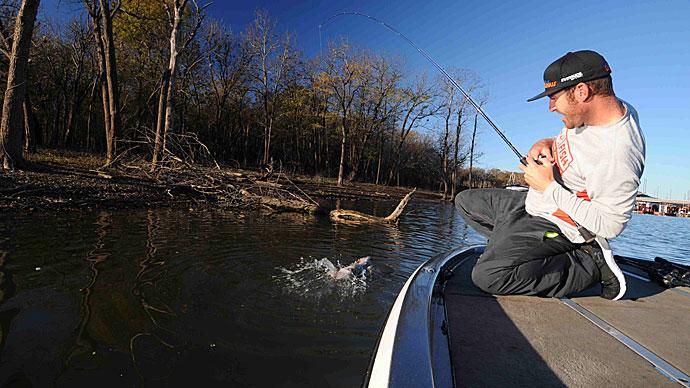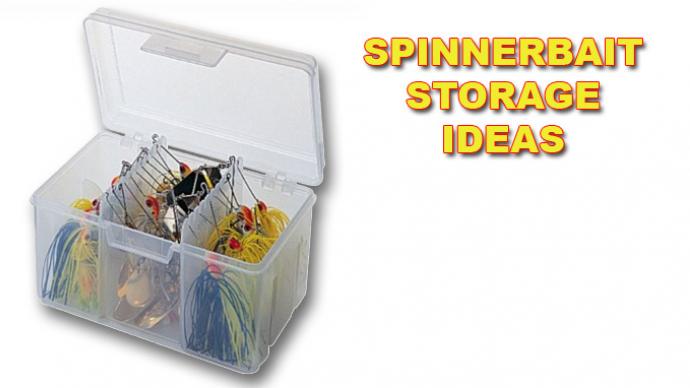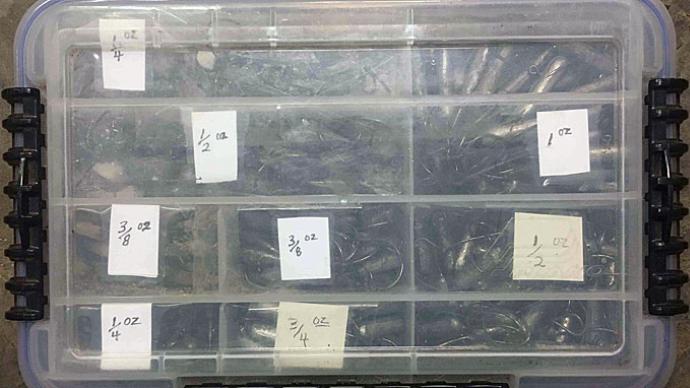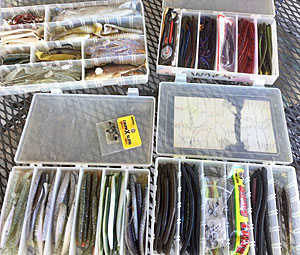
Being an outdoor writer, I’ve been in many other peoples’ boats, so I’ve seen various ways guys store and organize their soft plastics. One pro said that he has upwards of 300 pounds of plastics in his boat at any given time! How do you even begin to need that much in one day? Most of us do have a lot of plastics in the boat, and the problem is how to find the ones you need. The more you have, the more critical organization becomes.
A lot of people like to keep the plastics in the original bags. Maybe you want to keep the smell in, or you don’t want the colors to run. However, the bags they come in are usually stiff and bulky. If you feel like you need to keep them bagged up separately, why not put them in Ziploc® bags, the sandwich-sized ones? These roll up much smaller, you can fit several bags’ worth in each one, and they are easier to see through. You can add a shot of stink to them if you want before you seal up the bag. You can roll them up and stick them in the compartment of your worm box and even fit multiple colors in the same compartment.
Most worms don’t need to be stored in bags. Gulp® is one exception – they will dry out if not bagged. I called Berkley and asked them about how to store their plastics. The guy who answered the phone at customer service told me that they don’t need to be stored in bags, just climate-controlled. He said that their plastics will melt at 100 degrees. I’m not so sure about that. I live in Phoenix, and it gets way over 100 here regularly, so it’s even hotter in the locker. I’ve never had my PowerBaits melt. I know the plastic that the boxes were made of in the old days would melt some worms, but I don’t think that’s a problem anymore, as long as you buy boxes specifically for tackle. Some are even marketed as “worm proof”.
When you organize your baits, start by separating them into types. In other words, make a pile of worms, a pile of craws (I group craws and creatures, but if you have tons of both, separate them), a pile of lizards, etc. I’ve got tons of Senkos, lizards, worms, and small swimbaits, so those are separate for me. Once you’ve got them divided into groups, start looking at all the different baits you have of each kind. Do you use them all? I started using that new organization technique by the Japanese woman who says if it doesn’t give you joy, throw it out.
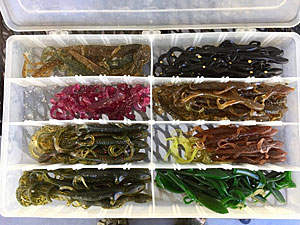
Once you start going through everything, you may discover that you have 58 bags of green 4-inch Yamamoto Kutworms (because they work so well!), but do you need to have all of those in the boat? Figure out how many you might need in a trip, and put those in the boat and the rest in the closet. You can restock as you use them. You may also find that you have stuff you never use. Why even keep those? That’s like hanging on to your junior high jeans because they might fit again someday. Toss it!
After you’ve got everything separated by type, put aside extras, and toss the ones you’ll never use, start organizing by color. I’ve managed to cull my plastics down to the point where I can get by with just having two categories: light and dark. (Except for Senkos, I have a box of laminates, lights, and darks.) Four-inch worms are one kind of baits that I have in abundance --more than will fit in one box, even just one box for darks. So for those, I have a box for various shades of purples, one for other darks like green, brown, black, etc., and one for light colors like morning dawn. You might have different bait depending on where you live and the lakes you fish in. Just try to get each type of bait down to where they will all fit in three boxes and make it easy to remember which color is where. If you have just a few of one color or a box with big deep compartments, put the worms in Ziploc® bags and stow more than one kind per section.
You don’t want to store your plastics all bent up, or they may stay that way. I have many different boxes because I’ve had so many boats over the years. I’m talking about those smaller boxes like the Plano Stowaway boxes. Some are smaller and have six compartments that run the short way – those are ideal for Senkos and swimbaits. Some are bigger and have lengthwise compartments that can be adjusted to have anywhere from 5 to over 30 compartments. Those are perfect for big worms, lizards, or even Hula Grubs. Since we have a center rod locker on our new boat, that leaves two big side lockers in the front deck. We keep all the plastics in the port locker and hard baits in the starboard one. We just put all the boxes in flat, so we don’t have to worry about the plastics sliding to the bottom and getting deformed.
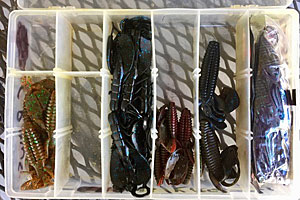
After you divide your plastics into the boxes, it helps you use a permanent marker and write what’s inside them. Depending on where and how you store the boxes, you might want to write it on the end, the top, the front – wherever shows when you open up the locker. For instance, we’ve got boxes that say “Dark Senkos,” “4-inch worms dark”, “big worms,” etc. This makes it easy to find what you’re looking for quickly.
Even though I know that’s another huge subject, a word about terminal tackle here. We keep ours simple – a box dedicated to finessing, with small hooks, dropshot hooks, small weights, etc. Then we have another box with nothing but football head jigs and other jigheads. This is a very sturdy box. A third box is for Texas and Carolina rigs. You might find you like a different setup. The key is to make it easy on yourself. You don’t want to spend half the day looking for stuff. I’ve been out with guys who literally throw all the bags into a locker. They open that locker and spend twenty minutes digging through a couple hundred bags of baits, looking for a 6-inch green worm. Crazy!
When you’re all done, you’ll probably have a couple of boxes (big boxes or small boxes – your choice) of each kind of bait – a dark box and a light box. You may have more than two boxes if you use a lot of a certain kind of plastic, and that’s fine – try to divide them up logically and mark the box so you can put your hand on the one you want quickly. Once you get your plastics organized and easy to find, you’ll find that you can spend more of your day fishing and less searching for the right bait. It will also make it easy to see which baits you need to stock up on next time you’re at the tackle shop. Divide and conquer!


